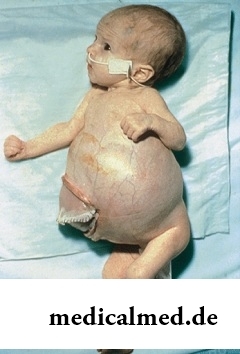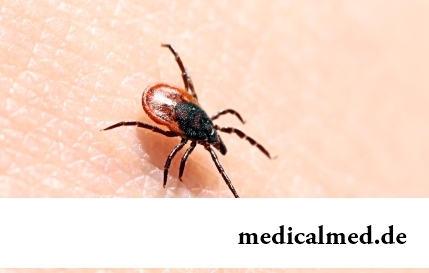





Neuroblastoma
Short characteristic of a disease
 The neuroblastoma is one of the most widespread malignant tumors which meet at children's age. This tumor takes the fourth place among new growths at children after leukoses, tumors of TsNS, malignant lymphoma and sarcomas. The tumor comes to light at quite early children's age, most often from 1 year to 3 years. The neuroblastoma at children can be localized in any part of a body, but localization behind a peritoneum and in the field of a postmediastinum has practical value.
The neuroblastoma is one of the most widespread malignant tumors which meet at children's age. This tumor takes the fourth place among new growths at children after leukoses, tumors of TsNS, malignant lymphoma and sarcomas. The tumor comes to light at quite early children's age, most often from 1 year to 3 years. The neuroblastoma at children can be localized in any part of a body, but localization behind a peritoneum and in the field of a postmediastinum has practical value.
Disease origins are up to the end not studied. Heredity is considered the only reliable factor.
Forms of neuroblastomas
Distinguish 4 forms of a neuroblastoma at children depending on type of cells and localization.
Melulloblastoma – is localized a tumor quite deeply in a cerebellum that makes impossible its removal by means of operation. It is characterized by bystry emergence of metastasises that leads to the bystry death of the child. The very first symptoms of development of a tumor are shown in an incoordination and balances.
The retinoblastoma is a malignant tumor which affects an eye retina at children. Development of a retinoblastoma leads to a blindness and metastasises in a brain.
The neurofibrosarcoma is a tumor of a sympathetic nervous system. It is localized in an abdominal cavity, gives metastasises in bones and lymph nodes.
The sympathoblastoma is a malignant tumor which is localized in a sympathetic nervous system and adrenal glands. It is formed at a fruit when forming a nervous system. The sympathoblastoma can be also localized in a chest cavity. Owing to increase in a tumor of adrenal glands the spinal cord can be surprised that it leads to paralysis of extremities.
Neuroblastoma stages
Distinguish 4 stages of development of a neuroblastoma in children:
The I stage - is characterized by localization of a neuroblastoma in the place of primary center;
The II stage – a tumor goes beyond primary center, but has no localization on other side of a backbone;
The III stage – a tumor extends to both sides of a backbone with damage of lymph nodes;
The IV stage – a neuroblastoma gives the remote metastasises in soft tissues, skeleton bones, lymph nodes, etc.
Neuroblastoma symptoms
The first signs of development of a neuroblastoma in children is pallor of integuments, decrease in apatite, vomiting, causeless whims, locks. Emergence of subfebrile temperature, increase of pulse, the increased perspiration, a hair loss is possible. In process of development and increase in a tumor the symptomatology accrues. It can be necessary for measurement of pulse rate пульсоксиметр.
At a retroperitoneal neuroblastoma increase in a circle of a stomach is observed, at a palpation the slow-moving and hilly tumor is probed. The costal arch can be turned out or protrusion in a waist from formation of a tumor is visible. It is quite often possible to notice a vascular grid in an upper part of a stomach and a thorax. The retroperitoneal neuroblastoma is characterized by very early changes in blood test, namely decrease in level of hemoglobin.
The neuroblastoma in the field of a mediastinum on an initial time proceeds asymptomatically. With progressing of a tumor its germination to the spinal canal is noted that leads to paralysis of upper and lower extremities, and also an incontience of urine and a chair.
Often parents notice symptoms of a disease which are caused not by a tumor, but metastasises. It is connected with the fact that the tumor early enough gives metastasises. The symptomatology depends on the place of localization of metastasises. At damage of bones of a skull it is possible to see tumoral hillocks, and also protrusion of eyes and hemorrhage on a pilar part of the head. At metastasises to the area of a liver its increase and tuberosity is observed. Damage of bones is characterized by pathological changes.
Diagnosis of a neuroblastoma
For diagnosis of a tumor perform inspection of the child with a stomach palpation thanks to which it is possible to reveal a tumor. Also appoint blood tests and urine, carry out ultrasonography and X-ray inspection, computer and magnetic and resonant therapy. The final diagnosis is made on the basis of a biopsy of a tumor and its histologic research.
Treatment of a neuroblastoma
Treatment of a neuroblastoma includes three main directions: use of chemotherapy, radiation therapy and operational method.
 Carry usually out complex treatment of a neuroblastoma using several methods. The first and second stage of a neuroblastoma is successfully treated by means of operation. Though removal of a retroperitoneal neuroblastoma is not always possible because of germination of a tumor in the next fabrics and bonds with the main vessels. Sometimes perhaps partial oncotomy. Radiation therapy has good effect.
Carry usually out complex treatment of a neuroblastoma using several methods. The first and second stage of a neuroblastoma is successfully treated by means of operation. Though removal of a retroperitoneal neuroblastoma is not always possible because of germination of a tumor in the next fabrics and bonds with the main vessels. Sometimes perhaps partial oncotomy. Radiation therapy has good effect.
At the correct treatment probability of recovery at children with a neuroblastoma of the first and second stage – rather high. The fourth stage has the bad forecast of a disease, five-year survival even when using the most modern programs of treatment does not exceed 20%.
According to WHO researches the daily half-hour conversation by the mobile phone increases probability of development of a tumor of a brain by 40%.

Tick-borne encephalitis – one of the most dangerous viral diseases which causative agents transfer and is given to people by ixodic mites. Эт...
Section: Articles about health
Cellulitis - very widespread cosmetic shortcoming which arises approximately at 80% of women sooner or later. Emergence it is connected with change of structure of a hypodermic fatty layer. At the same time on the surface of skin at first there are roughnesses (cambers...
Section: Articles about health
It is possible to find the extensive range of fruit and vegetables in modern shops. Russians already got used that on counters there is not only a seasonal domestic production, but the vegetables and fruit which are grown up in the countries with more comfortable conditions of cultivation at all seasons of the year. However what we see in shops and in the vegetable markets, is only a small part of those edible plants with which the nature is so rich. Today we want to acquaint the reader with rare and very useful vegetables which on...
Section: Articles about health
Eyes – unique body on the structure thanks to which the person obtains about 80% of information on the world around: about a form...
Section: Articles about health
Subfebrile temperature call fervescence to 38 degrees, and subfebrile condition - existence of such temperature over 3 days, and quite often it happens without the visible reasons. Existence of subfebrile condition - a strong indication of disturbances in an organism which can...
Section: Articles about health
Separate food - the system of meal based on digestion physiology which is carried to improvement methods. According to nutritionists, the separate use of the carbohydrate and proteinaceous products demanding different conditions of assimilation helps to get rid of diseases of digestive tract and serves as prophylactic from a diabetes mellitus, arthritis, food allergies, cholelithiasis and many other frustration. The essence of salutary effect of a method consists in most Kacha...
Section: Articles about health
Statistically, at the address to doctors seven of each ten patients complain of a headache. Actually people, periodically...
Section: Articles about health
We live during an advertizing era. Daily each person receives a solid portion of persuasive councils about what to eat to be healthy and successful. Products about which we will talk today are combined by the following circumstance: all of them are positioned as most...
Section: Articles about health
Life activity of one-celled fungi of the sort Candida, related to yeast is a proximate cause of development of candidiasis (milkwoman). Normal these microorganisms are a part of the microflora living in an oral cavity and intestines of most of people and also in a female genital tract. The pathological phenomena are observed when fungi begin to breed too violently. At the same time there is an inflammatory process affecting mucous membranes and which is shown very nepr...
Section: Articles about health
The modern person not always manages to find housing in the environmentally friendly region and such work which would not do harm здо...
Section: Articles about health
From the failure of work of immune system which is shown in the form of an allergy, statistically, more than 40% of the population of the globe suffer. In most cases pathological reactions cause the substances which are contained in food stuffs, hair of animals, medicines...
Section: Articles about health
All diseases from nerves – in this joke a big element of truth, are said by doctors. Constant stresses lead to decrease in protective forces of an organism, and it becomes vulnerable for a set of diseases. It is wrong to think that the stress is a problem of the present. Life of people and hundred, and one thousand years ago also abounded with problems therefore need of a relaxation understood in ancient times – to some techniques more than one thousand years. The person needs knowledge of how it is possible to relax, this knowledge пригод...
Section: Articles about health
All like to sing. Small children with pleasure are engaged in a vocal, not especially thinking of hit in a melody. Adults most often...
Section: Articles about health
The sudden heat on all body which is followed by perspiration and a cardiopalmus – the phenomenon familiar to many people. Most often such states called by "inflows" result from nervous or physical overworks and disappear right after rest. Odn...
Section: Articles about health
About 10-15 years ago existence of the computer in the apartment of the Russian was considered as a rarity and office rooms were only at the first stage of equipment by these useful devices. Today practically in each house there is a computer (and often not one), and a regular user is already every our second compatriot. Convenience and efficiency of personal computers are undoubted, but the people working with them daily have to know also about health hazard which they can predstavlit...
Section: Articles about health
Statistically, pathologies of a thyroid gland in the world more than 500 million people have. Failures in work of this body conduct to is heavy...
Section: Articles about health
What they, women? Beautiful, gentle, passionate and at the same time windy, gusty, and nervous. And what is stranger: have all these qualities of the woman at the same time. But here only the mood their time sharply changes on completely opposite: in the morning...
Section: Articles about health
All parents are ready to what the baby often and pisat much. Since then, as the absorbing diapers strongly became current, keeping of the kid in dryness does not represent any problems. But if the grown-up kid continues to urinate in panties, parents begin to feel concern – whether it is normal, or the kid has an urine incontience? Let's try to understand what is enuresis why it arises at children and at what age it is necessary to begin it to treat....
Section: Articles about health
The next flu epidemic leads to the next panic, from year to year we give in on these manipulations: professionally alarming goal...
Section: Articles about health
Smack in a mouth can arise in the natural way – as a result of lack of morning hygiene or reception of the corresponding food. However in certain cases its existence is a sign of certain pathologies, and allows to reveal an illness at an early stage. In we depend...
Section: Articles about health
Hemorrhoids – extremely widespread disease. Periodically arising inflammations and bleeding of hemorrhoidal nodes cause serious discomfort to nearly fifteen percent of adults. Meanwhile, having a clear idea of the reasons of an exacerbation of an illness and following rules of precaution, it is possible to reduce substantially sharpness of unpleasant feelings and to reduce progressing of a disease....
Section: Articles about health
We present to yours the TOP of the medicamentous means exerting the stimulating impact on a potentiality, i.e. on ability of a muzhcha...
Section: Articles about health
For residents of the countries of Southeast Asia various algas are an obligatory component of a daily diet. Their popularity is connected not only with high tastes, but also with numerous curative properties. Russians are a little familiar with...
Section: Articles about health
Life expectancy in various regions of Earth is not identical. Social stability, economic wellbeing, availability and level of medical care, household comfort, literacy of the population in the field of respect for sanitary and hygienic norms and many other factors exert impact on it. However one parameter remains to the general almost for all countries of the world: women on average live for 7-10 years longer, than men. Today we will talk about the reasons of this phenomenon....
Section: Articles about health
Ayurveda - the most ancient tselitelsky practice which came to us from India. It represents the doctrine about maintenance physical, ps...
Section: Articles about health
The winter swimming in open reservoirs called in our country by "winter swimming" – officially recognized sport and one of the most extreme ways of a hardening of an organism. This occupation has an old story and adherents in many countries. Are annually carried out...
Section: Articles about health
It is known that the person for 80% consists of water which participates in all processes of an organism. The person loses liquid daily – as a result of sweating, breath, an urination, and its insufficient completion due to various reasons can lead to dehydration of varying severity. Dehydration (dehydration) occurs already in case of loss of liquid in number of 1% of body weight and can result both in easy thirst, and by the death. In time to notice signs обезвож...
Section: Articles about health
